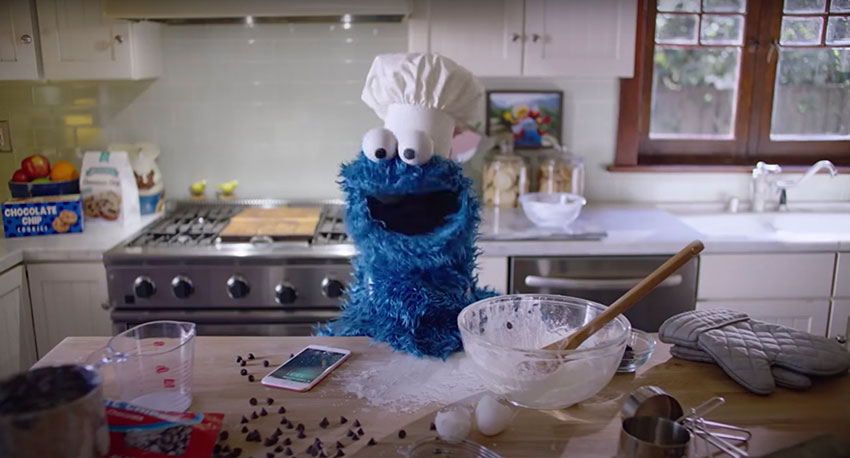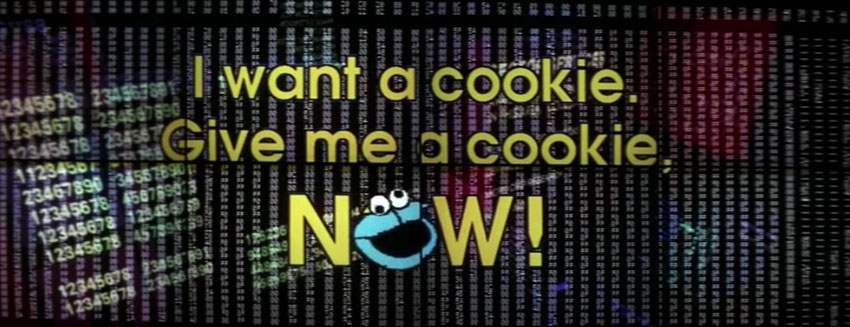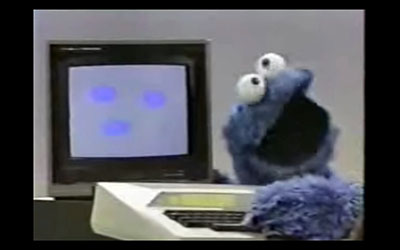Words by Lucy Hunter

Before he trained his appetite to edible fare, Cookie Monster devoured computers. In 1967, two years before Sesame Street hit the PBS airwaves, the woolly blue slouch debuted in a corporate film Jim Henson directed for IBM. Titled Coffee Break Machine, the 2.5-minute clip introduces a toothier beta version of Cookie Monster, who slavers at the gadgets on a computer-driven, talking coffeemaker voiced by a monotone Henson [1].
The beverage dispenser blathers about each shiny feature—imagine if the fussiest Keurig could introduce itself—just as the monster shovels them down his fuzzy maw. Intoning from inside a cavernous stomach, the swallowed-up machine announces it will self-destruct, and the scene reaches its finale in the tradition of so much cartoon slapstick, “KABOOM!”. Still, the joke’s on IBM.
The monster’s gleeful misappropriation of this cutting-edge technology reveals that the machine, not its googly-eyed predator, is silly and ineffectual. Coffee Break Machine would have landed especially well with its audience of IBM sales teams and other non-technical corporate departments. Screened during breaks at long meetings and training sessions, the film delivered precious minutes of Hensonian levity before the next battery of tutorials on the Selectric typewriter or some other newfangled product [2]. IBM established an internal ad division to help mediate between their abstruse technology and the uninitiated masses, including members of their own staff. Cookie Monster originated in this marketing context, channelling an unleashed id for the technologically perplexed.
The IBM film marks Cookie Monster’s first engagement with computers, but certainly not his last. Like a felted Forrest Gump, Cookie Monster has a knack for popping up at the scene of new technology. These appearances straddle product endorsements and tech-geek lore and have no single author or defining logic. Lined up in a row, however, they begin to tell a bigger story about the history of consumer technology. Cookie Monster helps us account for how gadgets like laptops and cell phones have wheedled their way into our lives—and why we accept the known coercions of Big Tech [3] in exchange for the latest appendage.
Since the 1960s, corporate marketers have persuaded the public to adopt new technology by softening the hard-edge treachery that clings to our perceptions of machinery, from Charlie Chaplin’s Modern Times to the umpteenth iteration of Terminator. Who better than a harmless, anthropomorphic shag rug like Cookie Monster to allay our suspicions? Cookie Monster’s cameos signal more than just the spooled inside jokes of tech culture. Rather, he charts the formulation of today’s retail technology consumer, the non-expert who in the late 1960s had never seen a computer but who in 2020 has an iPhone in their pocket and a Fitbit on their wrist. As Cookie wrestles with technology (often literally), so do we.


Not long after the IBM premiere, Cookie Monster found another starring role in tech history. In April 1973, a team of engineers in Palo Alto held their breath and flipped an “on” switch [4]. The success or failure of their latest venture, which they called the “personal computer,” hung in the split-second balance as the machine booted up. And voila! The first digital animation on the first monitor of the first PC munched its rudimentary path across the white depthless ground of a display screen. The familiar furry blob clutched the letter “C” in one paw and a cookie in the other.
His goofy beam would have rivalled those of overjoyed Xerox PARC staffers whose experiment, called the Alto, had just blinked miraculously into life. Like a tadpole crawling from the primordial ooze, our baggy galoot claims this original moment of what would become retail computing. Cookie Monster made a perfect digital icon for Alto’s revolutionary design principle: a computer so simple and accessible even a child could use it [5]. Xerox engineers sought to de-skill computers, rejecting the status quo of cloistered mainframes inside university labs operated by trained experts.
Instead, Xerox bet on a future where every household would have its own computer panting warmly under the desk, like a faithful Labrador [6]. Cookie Monster’s affable mug captured Xerox’s vision for the frictionless interface between an untrained consumer and an easy-to-use computer, a mascot for what we’d call “user-friendliness” today.
Even when he can’t claim attendance at big “firsts” in tech evolution, Cookie Monster retroactively wedges into the narrative. This is true for the invention of malware. In 1970 a few MIT undergrads surreptitiously fed lines of code onto a mainframe terminal left briefly unattended by a classmate [7]. The timer-activated sequence later froze that same terminal, issuing a ransom demand that the victim fed it a “COOKIE” before releasing its grip. Annoying but harmless, this electronic gnat became a geek sensation replicated across Multics computers nationwide.
The MIT student, Christopher Tavares, meant to reference the “cookie bear” mascot of erstwhile cereal commercials, but almost immediately, the malware’s sobriquet cemented the Sesame connection. To this day, it is known as “Cookie Monster,” a legacy cemented by the cult, peak-90s film Hackers. In one scene, the eponymous tech-punks antagonize a corporate villain with malware, sending in the floating head of Cookie Monster to gobble his way across the company’s delightfully exaggerated high-tech control centre [8]. Stemming the damage, the villain directs a confused underling to “type COOKIE, you idiot!”. Cookie Monster is enshrined in computing history as a hungry blue Pandora letting loose phishes, Trojan horses, spyware, and viruses upon the Internet.
(For its sheer nuisance, Cookie Monster malware seems to augur the dreaded internet cookie, those data packets that are harder to shake than glitter—but the term is a false cognate that has nothing to do with our Muppet).

By 1984 Cookie Monster had long outgrown his IBM teething phase (and indeed his teeth), but a tamped-down appetite for circuit boards still maintained. Accompanied by the ever-patient Maria on a Sesame Street skit [9], Cookie Monster sways to a calypso track and sings along as graphic cookies dance across the computer monitor. Maria demonstrates how to type commands, and Cookie’s mystification stands in for that of the toddlers at home who would also rather have a cookie than brave a QWERTY lesson. Cookie Monster puzzles over the mechanics: he wonders whether treats will fly out of the keyboard and whether he can eat the illustrations on the blue monitor screen.
Eventually resigned to the realities of representation—a cookie on the monitor is tragically just a simulacrum—Cookie Monster starts snarfing the keyboard to Maria’s dismay. This skit serves as a kind of way station in our narrative. The fleecy klutz craves computers but does not pose an existential threat as he did in the IBM commercial; meanwhile, PCs are gaining consumer popularity but are not nearly as ubiquitous as they are today.
Fast forward to 2016, the final instalment of our Cookie Monster highlight reel. Apple conscripted the Muppet in an ad for its hands-free assistant, who perks its ever-listening microphone to the magic words “Hey Siri” [10]. In the commercial, the aproned goof peers impatiently through an oven window at doughy unformed cookies as the dulcet-toned Siri ticks down the agonizing minutes until dessert is ready. Cookie paces, fumbles, and barely contains his impatience with duct tape’s kinetic energy over burst water main. Siri serenades Cookie Monster at his request with Jim Croce’s “Time in a Bottle.”
But here’s the thing: Despite his ravening, Cookie doesn’t leave so much as a dough-streaked smudge on the glossy smartphone. Pristine in the eye of a culinary whorl smattered with flours and chocolate chips, the iPhone sits conspicuously untouched and case-free. The monster even gobbles down a wooden spoon but casts nary a googly eye on the electrical amuse-bouche before him. Instead, he heeds her disembodied voice and by waiting for the timer to ding. What’s changed?


Cookie Monster’s arc as a mascot of Silicon Valley can be understood as a fable for how tech giants desire complacency from their customers—even as the products they sell are revealed for their discriminatory [11], invasive [12], and addictive [13] effects. Cookie Monster is a fuzzy, infantilized surrogate for the average consumer and their increasingly dependent relationship on corporate tech. We started with the merry anarchy of Cookie’s machine-munching at IBM, but we ended up in dutiful if pained, obedience to Siri’s internal clock. Of course, these are coincidences unconnected by any causal chain. But coincidence invites interpretation, and multiple repetitions subtend Cookie’s signifying power.
If you accept Cookie Monster as user-friendliness personified, consider how that term’s felicity papers over its negative impacts. For instance, ill-prepared consumers can’t possibly read the fine print in a typical “user agreement” yet are forced to relinquish unknown privacies with the graphic-design sleight of a checked box. Harmlessness and ease can conceal more complicated and inaccessible inner workings.
Moreover, Cookie’s is an ethos of constant consumption—one mirrored by tech’s habitual demand to purchase a newer model at intervals ordained by timed obsolescence. Cookie’s slackened stomach can never be filled, a truism both for the character and the physical construction of his baggy corpus. By mapping Cookie Monster onto the ideal tech customer, corporations clearly communicate: We are consumers in thrall to our appetites.
Cookie debuted with a winking joke about the excesses of IBM. Fifty years later, it turns out the joke’s on us. Allow a simple illustration: If you ask Siri right now, “What’s 0 divided by 0?” the iPhone’s snarky reply turns on the image of a subdued monster. Imagine that you have zero cookies and you split them evenly among zero friends. How many cookies does each person get? See? It doesn’t make sense. And Cookie Monster is sad that there are no cookies, and you are sad that you have no friends.






